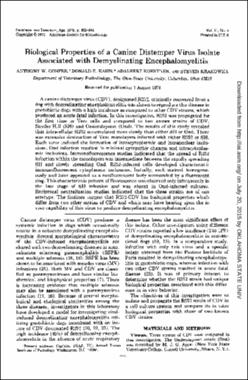| dc.contributor.author | Confer, Anthony W. | |
| dc.contributor.author | Kahn, Donald E. | |
| dc.contributor.author | Koestner, Adalbert | |
| dc.contributor.author | Krakowka, Steven | |
| dc.date.accessioned | 2015-10-16T20:47:53Z | |
| dc.date.available | 2015-10-16T20:47:53Z | |
| dc.date.issued | 1975-04 | |
| dc.identifier | okds_Confer_IAI_1975-04 | |
| dc.identifier.citation | Confer, A. W., Kahn, D. E., Koestner, A., & Krakowka, S. (1975). Biological properties of a canine distemper virus isolate associated with demyelinating encephalomyelitis. Infection and Immunity, 11(4), 835-844. https://doi.org/10.1128/iai.11.4.835-844.1975 | |
| dc.identifier.uri | https://hdl.handle.net/11244/19808 | |
| dc.description.abstract | A canine distemper virus (CDV), designated R252, originally recovered from a dog with demyelinating encephalomyelitis was shown to reproduce this disease in gnotobiotic dogs with a high incidence as compared to other CDV strains, which produced an acute fatal infection. In this investigation, R252 was propagated for the first time in Vero cells and compared to two known strains of CDV, Snyder-Hill (SH) and Onderstepoort (Ond). The results of this study revealed that intracellular R252 accumulated more slowly than either SH or Ond. There was extensive destruction of Vero monolayers infected with either R252 or SH. Each virus induced the formation of intracytoplasmic and intranuclear inclusions. Ond infection resulted in minimal cytopathic changes and intracytoplasmic inclusions. Immunofluorescence studies indicated that the spread of R252 infection within the monolayers was intermediate between the rapidly spreading SH and slowly spreading Ond. R252-infected cells developed characteristic immunofluorescent cytoplasmic inclusions. Initially, each stained homogeneously and later appeared as a nonfluorescent body surrounded by a fluorescent ring. This characteristic pattern of fluorescence was observed only infrequently in the late stage of SH infection and was absent in Ond-infected cultures. Reciprocal neutralization studies indicated that the three strains are of one serotype. The findings suggest that R252-CDV has biological properties which differ from two other strains of CDV and which may have bearing upon the in vivo capability of this virus to produce demyelinating encephalomyelitis. | |
| dc.format | application/pdf | |
| dc.language | en_US | |
| dc.publisher | American Society for Microbiology | |
| dc.rights | This material has been previously published. In the Oklahoma State University Library's institutional repository this version is made available through the open access principles and the terms of agreement/consent between the author(s) and the publisher. The permission policy on the use, reproduction or distribution of the material falls under fair use for educational, scholarship, and research purposes. Contact Digital Resources and Discovery Services at lib-dls@okstate.edu or 405-744-9161 for further information. | |
| dc.title | Biological properties of a canine distemper virus isolate associated with demyelinating encephalomyelitis | |
| osu.filename | okds_Confer_IAI_1975-04.pdf | |
| dc.description.peerreview | Peer reviewed | |
| dc.identifier.doi | 10.1128/iai.11.4.835-844.1975 | |
| dc.description.department | Veterinary Pathobiology | |
| dc.type.genre | Article | |
| dc.type.material | Text | |
